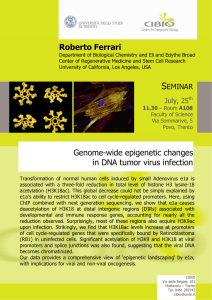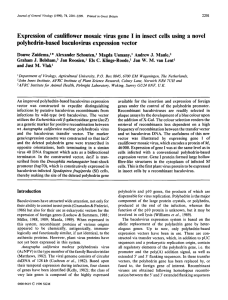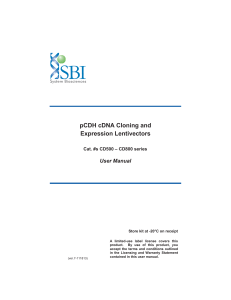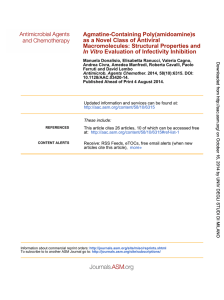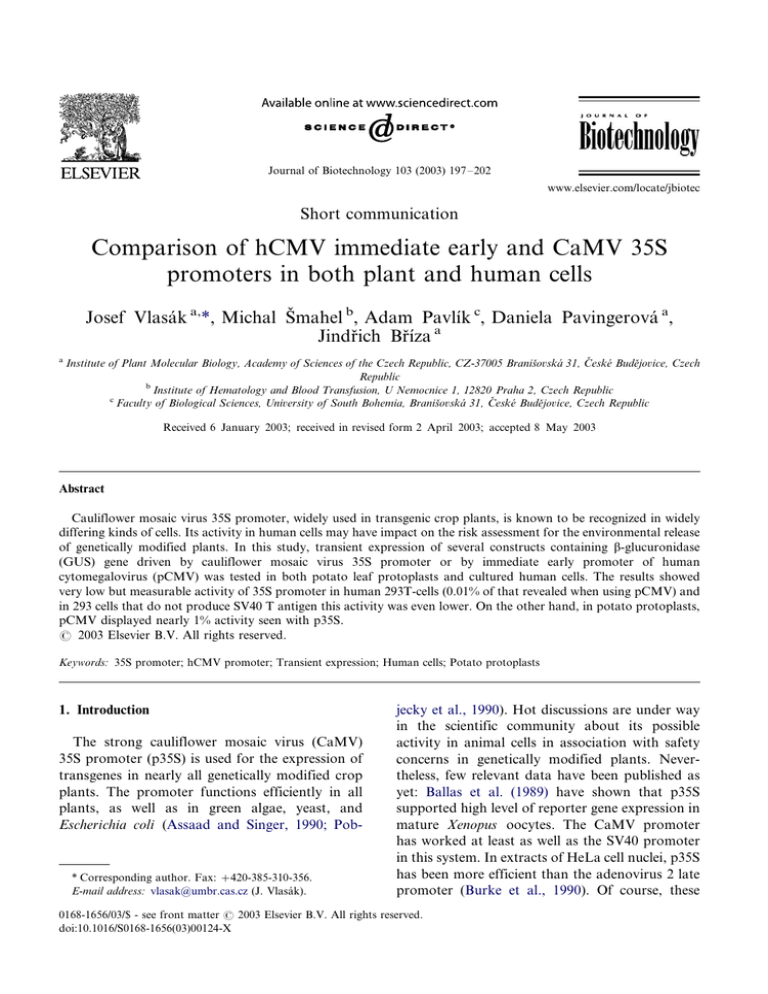
Journal of Biotechnology 103 (2003) 197 /202
www.elsevier.com/locate/jbiotec
Short communication
Comparison of hCMV immediate early and CaMV 35S
promoters in both plant and human cells
Josef Vlasák a,*, Michal Šmahel b, Adam Pavlı́k c, Daniela Pavingerová a,
Jindřich Břı́za a
a
Institute of Plant Molecular Biology, Academy of Sciences of the Czech Republic, CZ-37005 Branišovská 31, České Budějovice, Czech
Republic
b
Institute of Hematology and Blood Transfusion, U Nemocnice 1, 12820 Praha 2, Czech Republic
c
Faculty of Biological Sciences, University of South Bohemia, Branišovská 31, České Budějovice, Czech Republic
Received 6 January 2003; received in revised form 2 April 2003; accepted 8 May 2003
Abstract
Cauliflower mosaic virus 35S promoter, widely used in transgenic crop plants, is known to be recognized in widely
differing kinds of cells. Its activity in human cells may have impact on the risk assessment for the environmental release
of genetically modified plants. In this study, transient expression of several constructs containing b-glucuronidase
(GUS) gene driven by cauliflower mosaic virus 35S promoter or by immediate early promoter of human
cytomegalovirus (pCMV) was tested in both potato leaf protoplasts and cultured human cells. The results showed
very low but measurable activity of 35S promoter in human 293T-cells (0.01% of that revealed when using pCMV) and
in 293 cells that do not produce SV40 T antigen this activity was even lower. On the other hand, in potato protoplasts,
pCMV displayed nearly 1% activity seen with p35S.
# 2003 Elsevier B.V. All rights reserved.
Keywords: 35S promoter; hCMV promoter; Transient expression; Human cells; Potato protoplasts
1. Introduction
The strong cauliflower mosaic virus (CaMV)
35S promoter (p35S) is used for the expression of
transgenes in nearly all genetically modified crop
plants. The promoter functions efficiently in all
plants, as well as in green algae, yeast, and
Escherichia coli (Assaad and Singer, 1990; Pob-
* Corresponding author. Fax: /420-385-310-356.
E-mail address: [email protected] (J. Vlasák).
jecky et al., 1990). Hot discussions are under way
in the scientific community about its possible
activity in animal cells in association with safety
concerns in genetically modified plants. Nevertheless, few relevant data have been published as
yet: Ballas et al. (1989) have shown that p35S
supported high level of reporter gene expression in
mature Xenopus oocytes. The CaMV promoter
has worked at least as well as the SV40 promoter
in this system. In extracts of HeLa cell nuclei, p35S
has been more efficient than the adenovirus 2 late
promoter (Burke et al., 1990). Of course, these
0168-1656/03/$ - see front matter # 2003 Elsevier B.V. All rights reserved.
doi:10.1016/S0168-1656(03)00124-X
198
J. Vlasák et al. / Journal of Biotechnology 103 (2003) 197 /202
systems provide very anomalous transcription
conditions and for the typical animal cells the
results are probably irrelevant.
In this study, we compared the transient expression of bacterial b-glucuronidase (GUS) driven by
p35S in both plant and human cells. To evaluate
potency of p35S in human cells, p35S was exchanged with immediate early promoter of human
cytomegalovirus (pCMV) in several constructs,
and such cassettes were used as expression standards in human cells. pCMV is a very strong
promoter that is often utilized in mammalian
expression vectors (Boshart et al., 1985).
Besides comparison of p35S and pCMV in
human cells, the constructs with both promoters
were also simultaneously tested in plant protoplasts.
For comparison, N-terminal ORF I codons of
the ORF I/GUS fusion protein were excised from
the pCB0182 together with pCMV using digestion
with Bam HI in the linkers and religation to obtain
pCB1116-‘‘MonoGUS’’ without ORF I fusion.
Because of partial Bam HI digestion, pCB0192
was obtained, too, with the quasi-original MonoGUS structure. The only difference is the palindromic set of sites Kpn I, Sma I, Bam HI, Sma I,
Kpn I 9-bp downstream the CaMV p35S transcription start. Similarly, CaMV polyadenylation sequence was excised with the enzyme Sac I
(pCB1161; Fig. 1).
All plasmids were isolated by the ‘‘cleared lysate
method’’ and purified by cesium chloride/ethidium
bromide centrifugation (Sambrook et al., 1989).
They were dissolved in water and adjusted to 2 mg
DNA ml 1 before transfection.
2. Materials and methods
2.2. Potato protoplast transfection and GUS
activity assay
2.1. DNA constructs
‘‘MonoGUS’’ expression cassette containing
CaMV 35S promoter and the first 15 codons of
CaMV ORF I fused with the GUS gene (Bonneville et al., 1989) was used as standard in all
experiments. Signal for transcription termination
was derived from CaMV, too (Fig. 1). This
expression cassette in pUC plasmid was modified
using procedures for the preparation of recombinant DNA plasmids described by Sambrook et al.
(1989). Human cytomegalovirus promoter
(pCMV) was excised from the vector pBSC
(Šmahel et al., 2001) with enzymes Xba I and
Sal I, cloned into pUC18 and recloned so that it
was flanked by Kpn I sites. Kpn I fragment with
pCMV was inserted into Kpn I site of ‘‘MonoGUS’’, 9-bp downstream of the transcription start
of CaMV p35S, to obtain plasmid pCB0182 with
both promoters in tandem and set of sites Kpn I,
Sma I, Bam HI and Xba I in inverted orientation
flanking the pCMV (Fig. 1). CaMV p35S promoter was then excised by digestion with BspMII site
in front of p35S and partial digestion with XmaI in
the polylinker and religation. Resulting plasmid
pCB0199 has CaMV p35S replaced by pCMV in
the MonoGUS cassette.
Protoplasts were isolated from the leaf mesophyll cells of Solanum tuberosum L. cv. Bintje
according to Břı́za and Machová (1991). 0.5 /106
of freshly prepared protoplasts in 1 ml SW11
culture medium (Břı́za and Machová, 1991) were
PEG transfected (Negrutiu et al., 1987) with 50 mg
of pUC plasmid containing GUS expression
cassette. Protoplasts were incubated for 24 h,
collected, and lysed in 50 ml of GUS buffer
(Jefferson, 1987). GUS activity as well as the
protein content were measured in 10 ml of homogenate; the typical protein content was 0.5 /1.2 mg
ml1. GUS activity was assayed with the 4methylumbelliferyl-b-D-glucuronide (MUG) fluorescent substrate according to Jefferson (1987) and
proteins were determined according to Bradford
(1976).
2.3. Human cell transfection and GUS activity
assay
293 human embryonal kidney cells (Graham et
al., 1977) or 293T-cells derived from 293 cells by
transduction with the gene coding for simian virus
40 (SV40) large T antigen (DuBridge et al., 1987)
were used.
J. Vlasák et al. / Journal of Biotechnology 103 (2003) 197 /202
199
Fig. 1. Structure of the expression cassettes in pUC plasmids used for transfection. The bars represent segments of DNA that have
been inserted into plasmid vectors. The same symbols are used as in Table 1. Only relevant restriction sites are shown.
0.7 /106 of cells were seeded into 6-cm plates
and transfected on the next day by modified
calcium phosphate precipitation in HEPES-buf-
fered saline solution (Kingston et al., 1997) with 6
mg of plasmids. Cells were incubated for 48 h,
collected, and lysed in 200 ml of GUS buffer. GUS
200
J. Vlasák et al. / Journal of Biotechnology 103 (2003) 197 /202
activity and protein concentration were measured
as described for potato protoplasts. The typical
protein content was 0.7 /1.3 mg ml 1.
3. Results
The results of GUS assays are summarized in
Table 1. CaMV p35S promoter conferred very low
expression in human 293T-cells in all cassettes
studied (about 10,000 times lower than pCMV).
On the other hand, pCMV showed surprisingly
high activity in plant cells */only about 100 times
lower than the extremely strong plant p35S
promoter. To the best of our knowledge, this
observation has not yet been reported.
When pCMV was inserted between p35S and I/
GUS gene (pCB0182), the GUS activity was
substantially reduced in plant protoplasts. In
293T-cells, the expression of GUS from the
tandem of p35S-pCMV promoters was comparable with that from pCMV only.
N-terminal ORF I codons from the natural
CaMV 35S mRNA provide the optimal sequence
for the eucaryotic translation start resulting in very
high level of GUS expression in plant protoplasts
(Bonneville et al., 1989) as well as in transgenic
plants (Vlasák and Toušová, 1997). Deletion of the
ORF I codons (pCB 1116) that reveals the original
start codon of bacterial b-glucuronidase as the first
ATG on the mRNA causes drop of GUS activity
in potato protoplasts to about 6% and the deletion
of the CaMV transcription termination signal
(pCB 1161) had even stronger effect. All these
effects could also be seen in human cells, but a
more exact evaluation was impossible because of
low GUS activity. The results are in accordance
with the published data describing eucaryotic
translation start consensus sequence (Kozak,
1981) and mRNA stability improvement by appropriate polyadenylation sequence. Nevertheless,
the most pronounced drop of activity occurred
when using structure where symmetrical (palindromic) linker Kpn I/Sma I /Bam HI /Sma I /Kpn I
was obtained after several cloning steps 9-bp
downstream the mRNA cap (pCB0192). This
hairpin structure probably impairs ribosome landing on mRNA substantially. After excision of the
palindrom with enzyme Kpn I, we obtained plasmid pCB1117 with the same structure and activity
as ‘‘MonoGUS’’ (not shown in Table 1).
Human 293T-cells express T antigen of SV40
that has been shown to transactivate some viral
and cellular promoters (Rice and Cole, 1993). To
assess the influence of T antigen on the activity of
p35S and pCMV promoters, GUS activity was
also determined in 293 cells lacking T antigen. In
accordance with published data (Moens et al.,
Table 1
Expression of GUS in potato and human cells driven by CaMV 35S or hCMV promoters
Expression cassette
MonoGUS
pCB 0199
pCB 0182
pCB 1116
pCB 1161
pCB 0192
Structure
p35S-I/GUS!
pCMV-I/GUS!
p35S-pCMV-I/GUS!
p35S-GUS!
p35S-I/GUS
p35S-MCS-I/GUS!
Relative activity (%)
Potato protoplasts
293T-cells
100
0.619/0.16
0.739/0.02
6.59/1.2
5.09/0.3
1.509/0.14
0.0129/0.002
100
1069/4
0.0059/0.004
0.0019/0.001
0.0079/0.001
Each value represents the mean of three repeated experiments9/standard deviation. ‘‘MonoGUS’’ cassette was always used as a
standard. Its absolute activity varied in potato protoplasts in the range 210 /920 pmol MUG min1 mg protein1 and the actual value
was used as 100% in each experiment. In human cells, the range for MonoGUS was 0.14 /0.33 pmol MUG min1 mg protein 1.
pCB0199 with the same fusion driven by hCMV promoter was used as a 100% standard in experiments with human cells. The activities
determined varied in the range 1100 /2420 pmol MUG min 1 mg protein1. The background increase of fluorescence represented
maximally 0.1 pmol MUG min1. Symbols: p35S: CaMV 35S promoter; pCMV: hCMV immediate early promoter;
!: CaMV transcription termination signal, I: first 15 codons of CaMV ORF I; MCS: multiple cloning site-sequence with restriction
sites Kpn I /Sma I /Bam HI /Sma I /Kpn I.
J. Vlasák et al. / Journal of Biotechnology 103 (2003) 197 /202
2001), these experiments demonstrated profound
effect of T antigen on the expression driven by
pCMV (GUS activity was 10 /20 times lower in
293 cells*/data not shown). Activity of p35S was
reduced similarly in the absence of T antigen.
201
This work was supported by the Grant Agency of
the Czech Republic, Grant No. GA310/00/0381.
References
4. Discussion
GUS expression driven by p35S promoter could
be readily detected in 293T human cells, although
in a much lower extent than in plant protoplasts.
Nevertheless, such direct comparison is of little
value because of very different conditions for
DNA transfection in different cell types. Comparison of CaMV 35S (plant) and hCMV (animal)
promoters in each type of cells (Table 1) shows
several thousand times lower activity of p35S in
human cells. It indicates that the potential hazards
associated with the use of p35S may not be so
serious as it is sometimes maintained. Recent
reports have suggested that because of a proposed
‘recombination hotspot’, the consumption of
transgenic plants that contain the 35S promoter
may result in ‘inappropriate overexpression of
genes’ leading to cancer in humans, or that
recombination may lead to the reactivation of
‘dormant viruses’ or the creation of ‘new viruses’
(Ho et al., 1999). It is questionable whether
relatively low transcription activity of CaMV 35S
promoter can induce such hazardous events in
mammalian cells.
On the other hand, only about 100-fold lower
expression of widely used animal pCMV in plant
cells is surprising. Expression levels this high have
not even been reported with some genuine plant
promoters. This fact should be kept in mind in the
course of design and use of eucaryotic expression
vectors.
Acknowledgements
We are grateful to Dr. T. Hohn for the gift of
the MonoGUS expression cassette used in this
study. We would also like to thank Dr. Šárka
Nemecková and Prof. V. Vonka for many helpful
discussions and critical reading of the manuscript.
Assaad, F.F., Singer, E.R., 1990. Cauliflower mosaic virus p35S
promoter activity in Escherichia coli . Mol. Gen. Genet. 223,
517 /520.
Ballas, N., Broido, S., Soreq, H., Loyter, A., 1989. Efficient
functioning of plant promoters and poly(A) sites in Xenopus
oocytes. Nucl. Acids Res. 17, 7891 /7903.
Bonneville, J.M., Sanfaçon, H., Fütterer, J., Hohn, T., 1989.
Posttranscriptional trans-activation in cauliflower mosaic
virus. Cell 59, 1135 /1143.
Boshart, M., Weber, F., Jahn, G., Dorsch-Hasler, K., Fleckenstein, B., Schaffner, W., 1985. A very strong enhancer is
located upstream of an immediate early gene of human
cytomegalovirus. Cell 41, 521 /530.
Bradford, M.M., 1976. A rapid and sensitive method for the
quantitation of microgram quantities of protein utilizing the
principle of protein-dye binding. Anal. Biochem. 72, 248 /
254.
Břı́za, J., Machová, I., 1991. Regeneration of plants from leaf
mesophyll protoplasts of the tetraploid potato cultivars
Xenia and Bintje. Biol. Plant. 33, 225 /233.
Burke, C., Yu, X.B., Marchitelli, L., Davis, E.A., Ackerman,
S., 1990. Transcription factor IIA of wheat and human
function similarly with plant and animal viral promoters.
Nucl. Acids Res. 18, 3611 /3620.
DuBridge, R.B., Tang, P., Hsia, H.C., Leong, P.M., Miller,
J.H., Calos, M.P., 1987. Analysis of mutation in human
cells by using an Epstein-Barr virus shuttle system. Mol.
Cell. Biol. 7, 379 /387.
Graham, F.L., Smiley, J., Russell, W.C., Nairn, R., 1977.
Characteristics of a human cell line transformed by DNA
from human adenovirus type 5. J. Gen. Virol. 36, 59 /74.
Ho, M.-W., Ryan, A., Cummins, J., 1999. Cauliflower mosaic
viral promoter */a recipe for disaster? Microb. Ecol. Health
Dis. 11, 194 /197.
Jefferson, R.A., 1987. Assaying chimeric genes in plants: the
GUS gene fusion system. Plant. Mol. Biol. Rep. 5, 387 /405.
Kingston, R.E., Chen, C.A., Okayama, H., Rose, J.K., 1997.
Calcium phosphate transfection. In: Ausubel, F.M., Brent,
R., Kingston, R.E., Moore, D.D., Seidman, J.G., Smith,
J.A., Struhl, K. (Eds.), Current Protocols in Molecular
Biology. Wiley, New York, pp. 9.1.4 /9.1.11.
Kozak, M., 1981. Possible role of flanking nucleotides in
recognition of the AUG initiator codon by eucaryotic
ribosomes. Nucl. Acids Res. 9, 5233 /5252.
Moens, U., Van Ghelue, M., Kristoffersen, A.K., Johansen, B.,
Rekvig, O.P., Degre, M., Rollag, H., 2001. Simian virus 40
large T-antigen, but not small T-antigen, trans-activates the
human cytomegalovirus major immediate early promoter.
Virus Genes 23, 215 /226.
202
J. Vlasák et al. / Journal of Biotechnology 103 (2003) 197 /202
Negrutiu, I., Shillito, R., Potrykus, I., Biasini, G., Sala, F.,
1987. Hybrid genes in the analysis of transformation
conditions. 1. Setting up a simple method for direct genetransfer in plant-protoplasts. Plant. Mol. Biol.
8, 363 /373.
Pobjecky, N., Rosenberg, G.H., Dinter-Gottlieb, G., Käufer,
N.F., 1990. Expression of the b-glucuronidase gene under
the control of the CaMV 35S promoter in Schizosacharomyces pombe . Mol. Gen. Genet. 220, 314 /316.
Rice, P.W., Cole, C.N., 1993. Efficient transcriptional activation of many simple modular promoters by simian virus 40
large T antigen. J. Virol. 67, 6689 /6697.
Sambrook, K., Fritsch, E.F., Maniatis, T., 1989. Molecular
Cloning: A Laboratory Manual. Cold Spring Harbor Press,
New York, USA.
.Šmahel, M., Šı́ma, P., Ludvı́ková, V., Vonka, V., 2001.
Modified HPV16 E7 genes as DNA vaccine against E7containing oncogenic cells. Virology 281, 231 /238.
Vlasák, J., Toušová, M., 1997. Gene dosis effects in plants
transgenic for monocistronic and activated dicistronic GUS
constructs. In: Book of Abstracts from ‘‘2nd Symp. Ser.
Recent Advances in Plant Biotechnology: Molecular Biology for Agriculture’’, České Budějovice, August 25 /29,
UMBR AV ČR České Budĕjovice, p 159.

